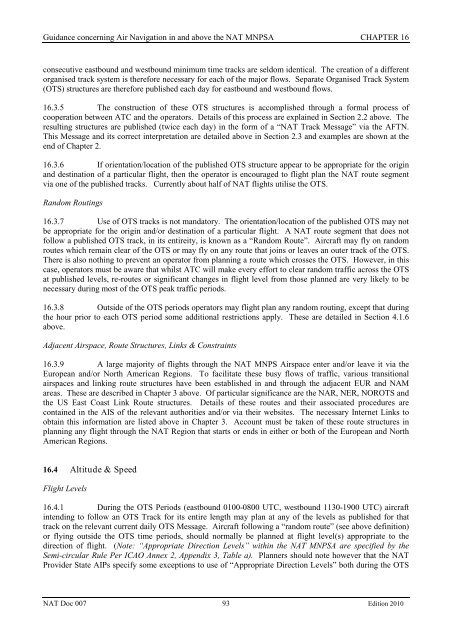World Air Ops | NAT | Doc 007 MNPS Guidance
World Air Ops | NAT | Doc 007 MNPS Guidance
World Air Ops | NAT | Doc 007 MNPS Guidance
You also want an ePaper? Increase the reach of your titles
YUMPU automatically turns print PDFs into web optimized ePapers that Google loves.
<strong>Guidance</strong> concerning <strong>Air</strong> Navigation in and above the <strong>NAT</strong> <strong>MNPS</strong>A CHAPTER 16consecutive eastbound and westbound minimum time tracks are seldom identical. The creation of a differentorganised track system is therefore necessary for each of the major flows. Separate Organised Track System(OTS) structures are therefore published each day for eastbound and westbound flows.16.3.5 The construction of these OTS structures is accomplished through a formal process ofcooperation between ATC and the operators. Details of this process are explained in Section 2.2 above. Theresulting structures are published (twice each day) in the form of a “<strong>NAT</strong> Track Message” via the AFTN.This Message and its correct interpretation are detailed above in Section 2.3 and examples are shown at theend of Chapter 2.16.3.6 If orientation/location of the published OTS structure appear to be appropriate for the originand destination of a particular flight, then the operator is encouraged to flight plan the <strong>NAT</strong> route segmentvia one of the published tracks. Currently about half of <strong>NAT</strong> flights utilise the OTS.Random Routings16.3.7 Use of OTS tracks is not mandatory. The orientation/location of the published OTS may notbe appropriate for the origin and/or destination of a particular flight. A <strong>NAT</strong> route segment that does notfollow a published OTS track, in its entireity, is known as a “Random Route”. <strong>Air</strong>craft may fly on randomroutes which remain clear of the OTS or may fly on any route that joins or leaves an outer track of the OTS.There is also nothing to prevent an operator from planning a route which crosses the OTS. However, in thiscase, operators must be aware that whilst ATC will make every effort to clear random traffic across the OTSat published levels, re-routes or significant changes in flight level from those planned are very likely to benecessary during most of the OTS peak traffic periods.16.3.8 Outside of the OTS periods operators may flight plan any random routing, except that duringthe hour prior to each OTS period some additional restrictions apply. These are detailed in Section 4.1.6above.Adjacent <strong>Air</strong>space, Route Structures, Links & Constraints16.3.9 A large majority of flights through the <strong>NAT</strong> <strong>MNPS</strong> <strong>Air</strong>space enter and/or leave it via theEuropean and/or North American Regions. To facilitate these busy flows of traffic, various transitionalairspaces and linking route structures have been established in and through the adjacent EUR and NAMareas. These are described in Chapter 3 above. Of particular significance are the NAR, NER, NOROTS andthe US East Coast Link Route structures. Details of these routes and their associated procedures arecontained in the AIS of the relevant authorities and/or via their websites. The necessary Internet Links toobtain this information are listed above in Chapter 3. Account must be taken of these route structures inplanning any flight through the <strong>NAT</strong> Region that starts or ends in either or both of the European and NorthAmerican Regions.16.4 Altitude & SpeedFlight Levels16.4.1 During the OTS Periods (eastbound 0100-0800 UTC, westbound 1130-1900 UTC) aircraftintending to follow an OTS Track for its entire length may plan at any of the levels as published for thattrack on the relevant current daily OTS Message. <strong>Air</strong>craft following a “random route” (see above definition)or flying outside the OTS time periods, should normally be planned at flight level(s) appropriate to thedirection of flight. (Note: “Appropriate Direction Levels” within the <strong>NAT</strong> <strong>MNPS</strong>A are specified by theSemi-circular Rule Per ICAO Annex 2, Appendix 3, Table a). Planners should note however that the <strong>NAT</strong>Provider State AIPs specify some exceptions to use of “Appropriate Direction Levels” both during the OTS<strong>NAT</strong> <strong>Doc</strong> <strong>007</strong> 93 Edition 2010
















